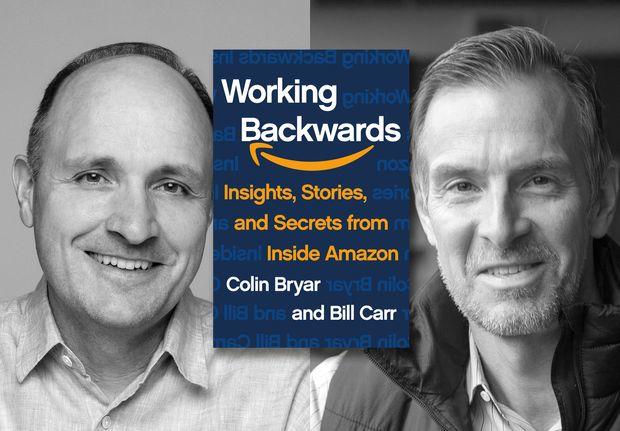Colin Bryar joined Amazon in 1998 — four years after its founding — and spent the next 12 years as part of Amazon’s senior leadership team as Amazon grew from a domestic (US-only) seller of books to a global, multi-dimensional powerhouse and innovator. For two of his years at Amazon, Colin was “Chief of Staff” to Jeff Bezos, aka “Jeff’s shadow,” during which he spent each day attending meetings, traveling with, and discussing business and life with Jeff.
Bill Carr joined Amazon in 1999 and spent more than 15 years with the company. As vice president of Digital Media, Bill launched and managed the company’s global digital music and video businesses, including Amazon Music, Prime Video, and Amazon Studios.
Colin Bryar and Bill Carr, authors of Working Backwards: Insights, Stories, and Secrets from Inside Amazon
Today Bryar and Carr are co-founders of Working Backwards LLC where they coaches executives at both large and early-stage companies on how to implement the management practices developed at Amazon. Bryar and Carr are also the co-authors of Working Backwards: Insight, Stories, and Secrets from Inside Amazon. Working Backwards is a practical guidebook and a corporate narrative, filled with the authors’ in-the-room recollections of what “Being Amazonian” is like and how it has affected their personal and professional lives. They demonstrate that success on Amazon’s scale is not achieved by the genius of any single leader, but rather through a commitment to and execution of a set of well-defined, rigorously-executed principles and practices — shared here for the very first time.
To learn more about the success and leadership principles of Amazon, an invention machine, Ray Wang, CEO and founder of a Silicon Valley-based advisory firm Constellation Research, and I invited Bryar and Carr to our weekly show DisrupTV. Here are the key takeaways from our conversation with Colin Bryar and Bill Carr.
Leadership Principles
Amazon developed a whole set of scalable and repeatable processes, combined with 14 leadership principles, that helped Amazon become an invention machine. This machine is applicable to all company sizes or sectors. The leadership principles started as 10 in 2005 and grew to 14 today.
The 14 Amazon Leadership Principles:
Customer Obsession: Leaders start with the customer and work backward. They work vigorously to earn and keep customer trust. Although leaders pay attention to competitors, they obsess over customers.Ownership: Leaders are owners. They think long-term and don’t sacrifice long-term value for short-term results. They act on behalf of the entire company, beyond just their own team. They never say “that’s not my job.”Invent and Simplify: Leaders expect and require innovation and invention from their teams and always find ways to simplify. They are externally aware, look for new ideas from everywhere, and are not limited by “not invented here.” As we do new things, we accept that we may be misunderstood for long periods of time.Are Right, A Lot: Leaders are right a lot. They have strong judgment and good instincts. They seek diverse perspectives and work to disconfirm their beliefs.Learn and Be Curious: Leaders are never done learning and always seek to improve themselves. They are curious about new possibilities and act to explore them.Hire and Develop the Best: Leaders raise the performance bar with every hire and promotion. They recognize exceptional talent and willingly move them throughout the organization. Leaders develop leaders and take seriously their role in coaching others. We work on behalf of our people to invent mechanisms for development like Career Choice.Insist on the Highest Standards: Leaders have relentlessly high standards — many people may think these standards are unreasonably high. Leaders are continually raising the bar and drive their teams to deliver high-quality products, services, and processes. Leaders ensure that defects do not get sent down the line and that problems are fixed so they stay fixed.Think Big: Thinking small is a self-fulfilling prophecy. Leaders create and communicate a bold direction that inspires results. They think differently and look around corners for ways to serve customers.Bias for Action: Speed matters in business. Many decisions and actions are reversible and do not need extensive study. We value calculated risk-taking. Frugality: Accomplish more with less. Constraints breed resourcefulness, self-sufficiency, and invention. There are no extra points for growing headcount, budget size, or fixed expense.Earn Trust: Leaders listen attentively, speak candidly, and treat others respectfully. They are vocally self-critical, even when doing so is awkward or embarrassing. Leaders do not believe their or their team’s body odor smells of perfume. They benchmark themselves and their teams against the best.Dive Deep: Leaders operate at all levels, stay connected to the details, audit frequently, and are skeptical when metrics and anecdotes differ. No task is beneath them.Have Backbone; Disagree and Commit: Leaders are obligated to respectfully challenge decisions when they disagree, even when doing so is uncomfortable or exhausting. Leaders have conviction and are tenacious. They do not compromise for the sake of social cohesion. Once a decision is determined, they commit wholly.Deliver Results: Leaders focus on the key inputs for their business and deliver them with the right quality and in a timely fashion. Despite setbacks, they rise to the occasion and never settle.
14 Amazon principles
•Customer Obsession
•Ownership
•Invent & Simplify
•Are Right, A Lot
•Learn, Be Curious
•Hire & Develop Best
•Highest Standards
•Think Big
•Bias for Action
•Frugality
•Earn Trust
•Dive Deep
•Have Backbone
•Deliver Results https://t.co/m8ABeuxaKr— Vala Afshar (@ValaAfshar) March 10, 2021
The Amazonian Mindset is developed based on how well employees use these 14 leadership principles in terms of how they worked – making decisions, creating, and servicing stakeholders. Carr told us that he referenced these principles in meetings, how he recruited talent, performance coaching and feedback, and his daily decision-making processes. Carr arrived at the right decisions by always referring back to the leadership principles. The principles were created to scale the business without drifting away from the brand promise.
Working Backward
Working backward is a very specific process at Amazon. This process applies to small features, new products, or new lines of business. Working backward means starting from the customer experience and working backward from that. A lot of organizations being with a ‘skills forward’ approach, analyzing core competencies, competitive landscape, and what is traditionally a SWAT analysis – strengths, weaknesses, opportunities, and threats. What is missing here according to Bryar is the customer’s point of view and anticipated experience. Amazon inverted this process, looking at the customer experience at the beginning. The working backward process begins with an internal creation of a press release.
Before Amazon commits to building a new product or service, Amazon leaders write a press release, clearly defining the problem and the solution. The process of writing a press release is a forcing function for the team to clearly articulate the customer benefit, focusing on what makes the product or service unique and valuable in the market. Why is the product or service good for the customer? If the team is not excited about the press release, then the team must continue to refine the document. Accompanies with the press release is also a frequently asked questions document, providing a detailed set of value propositions and company differentiation. Most of the press release drafts are not pursued by Amazon.
Another example of applying a process that would reinforce the working backward framework was the memo-writing process. in 2004 Amazon banned PowerPoint as a tool for presenting new ideas. Instead, Amazon adopted a memo writing process as a tool to provide more context, clarity, and the opportunity for deeper analysis and conversations. The leadership team would begin the meeting by reading the memo and then discuss the merits of the proposal.
I make sure all my meetings do not have tight agendas. Tight agendas assume you know where you’re going, which for a certain kind of meeting is right —like a weekly business review and going through metrics. But most meetings should be used for mild brainstorming.
—@JeffBezos pic.twitter.com/MOPY0xAAGL
— Vala Afshar (@ValaAfshar) December 13, 2017
Customer obsessed is different and better than being competitor obsessed
Customer obsession is key to Amazon’s success. Carr explains to us that Amazon is a customer-obsessed company, not a competitor-obsessed company. The problem with being competitor-obsessed is that if your company becomes a number one product category leader, then you may not have the driving function or urgency to continuously improve and grow. The benefit of being customer-obsessed is knowing that customers are always wonderfully discontent. Customer’s expectations will always rise over time – faster, cheaper, and more convenient. A customer-obsessed company is in a perpetual state of always knowing there is more to do. Bryar spoke about starting with the customer experience with regards to their digital products and services. Understanding the entire value change, and knowing the importance of getting closer to the end-user, led Amazon towards creating a device for a beautiful digital reading experience Amazon continues to work across a number of different business, growing from scratch to very large businesses, by going very deep into understanding the customer experience.
Another important success factor for Amazon is the spirit of innovation. Bryar gave a number of examples where senior Amazon executives shifted their focus on non-existing businesses, instead of continuing to manage a growing and very large Amazon businesses. Inventing on behalf of customers is highly encourage and rewarded at Amazon.
Bryar encourages business leaders to develop their own leadership principles, for scaling the business and recruitment of new talent. Bryar also encourages changing the process of presenting to developing narratives using the memo process. Lastly, Bryar talked about measuring success of identifying controllable input metrics. Most companies focus on output metrics like revenue and profit. Amazon places a greater importance on the metrics for inputs they directly control, like price or convenience. Quality input metrics will have a great impact on the outputs. The path to using the Amazon process is a journey and it will take focus, discipline, and a long-term view to create sustainable momentum and success. Bryar reminds us that long-term thinking doesn’t mean it takes longer for you to reach your goals. Long-term thinking simply minimizes distractions and often speeds you up and gets you quicker to where you want to be.
I highly encourage you to watch the entire conversation with Bryar and Carr to learn more about the insights, stories, and secrets behind Amazon’s success.



